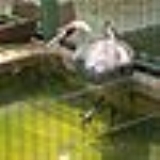
Hooded Crane
Encyclopedia
The Hooded Crane, Grus monacha is a small, dark crane
. It has a grey body. The top of the neck and head is white, except for a patch of bare red skin above the eye. It is one of the smallest cranes, but is still a fairly large bird, at 1 m (3.3 ft) long, a weight of 3.7 kg (8.2 lbs) and a wingspan of 1.87 m (6.2 ft).
The Hooded Crane breeds in south-central and south-eastern Siberia
. Breeding is also suspected in Mongolia
. Over 80% of its population winters at Izumi
, southern Japan
. There are also wintering grounds in South Korea
and China
.
The estimated population of the species is between 9,500 individuals. The major threats to its survival are wetland loss and degradation in its wintering grounds in China and South Korea as a result of reclamation for development and dam building.
The Hooded Crane is evaluated as Vulnerable
on the IUCN Red List
of Threatened Species. It is listed on Appendix I and II of CITES. A society, Grus monacha International Aid (白头鹤的故事), has been formed to find ways to protect the species.
Crane (bird)
Cranes are a family, Gruidae, of large, long-legged and long-necked birds in the order Gruiformes. There are fifteen species of crane in four genera. Unlike the similar-looking but unrelated herons, cranes fly with necks outstretched, not pulled back...
. It has a grey body. The top of the neck and head is white, except for a patch of bare red skin above the eye. It is one of the smallest cranes, but is still a fairly large bird, at 1 m (3.3 ft) long, a weight of 3.7 kg (8.2 lbs) and a wingspan of 1.87 m (6.2 ft).
The Hooded Crane breeds in south-central and south-eastern Siberia
Siberia
Siberia is an extensive region constituting almost all of Northern Asia. Comprising the central and eastern portion of the Russian Federation, it was part of the Soviet Union from its beginning, as its predecessor states, the Tsardom of Russia and the Russian Empire, conquered it during the 16th...
. Breeding is also suspected in Mongolia
Mongolia
Mongolia is a landlocked country in East and Central Asia. It is bordered by Russia to the north and China to the south, east and west. Although Mongolia does not share a border with Kazakhstan, its western-most point is only from Kazakhstan's eastern tip. Ulan Bator, the capital and largest...
. Over 80% of its population winters at Izumi
Izumi crane migration grounds
The Izumi crane migration grounds cover a 245ha paddy field area of Izumi plain in the northwest of Kagoshima Prefecture known for the about ten-thousand cranes which pass the winter there from every year mid October to March.- Migration :...
, southern Japan
Japan
Japan is an island nation in East Asia. Located in the Pacific Ocean, it lies to the east of the Sea of Japan, China, North Korea, South Korea and Russia, stretching from the Sea of Okhotsk in the north to the East China Sea and Taiwan in the south...
. There are also wintering grounds in South Korea
South Korea
The Republic of Korea , , is a sovereign state in East Asia, located on the southern portion of the Korean Peninsula. It is neighbored by the People's Republic of China to the west, Japan to the east, North Korea to the north, and the East China Sea and Republic of China to the south...
and China
China
Chinese civilization may refer to:* China for more general discussion of the country.* Chinese culture* Greater China, the transnational community of ethnic Chinese.* History of China* Sinosphere, the area historically affected by Chinese culture...
.
The estimated population of the species is between 9,500 individuals. The major threats to its survival are wetland loss and degradation in its wintering grounds in China and South Korea as a result of reclamation for development and dam building.
The Hooded Crane is evaluated as Vulnerable
Vulnerable species
On 30 January 2010, the IUCN Red List of Threatened Species identified 9694 Vulnerable species, subspecies and varieties, stocks and sub-populations.-References:...
on the IUCN Red List
IUCN Red List
The IUCN Red List of Threatened Species , founded in 1963, is the world's most comprehensive inventory of the global conservation status of biological species. The International Union for Conservation of Nature is the world's main authority on the conservation status of species...
of Threatened Species. It is listed on Appendix I and II of CITES. A society, Grus monacha International Aid (白头鹤的故事), has been formed to find ways to protect the species.
External links
- BirdLife Species Factsheet
- Hooded Crane (Grus monachus) from Cranes of the World (1983) by Paul Johnsgard

